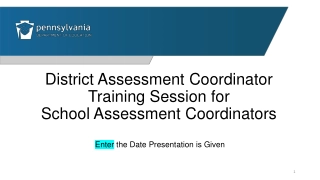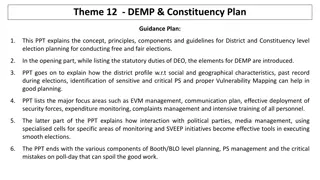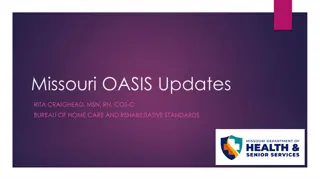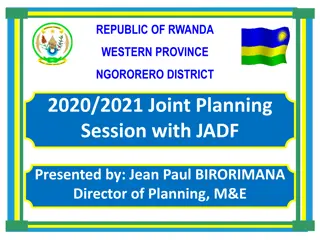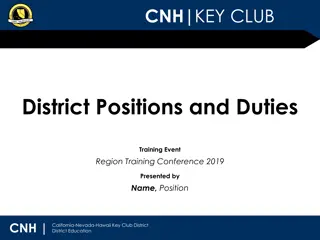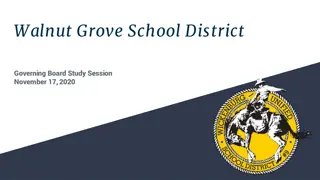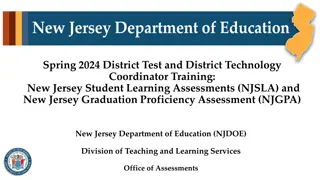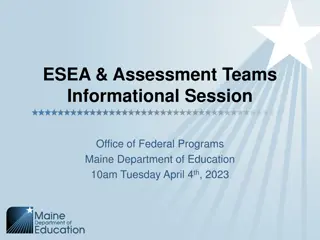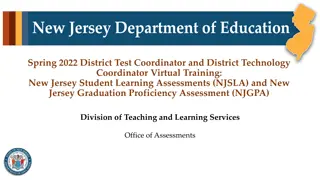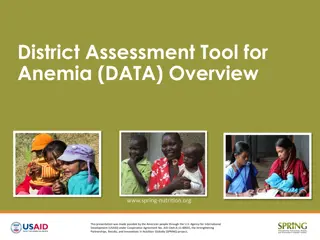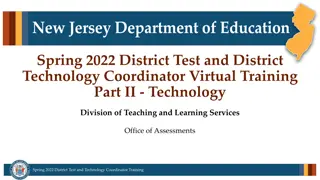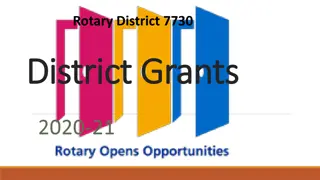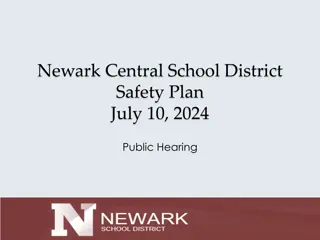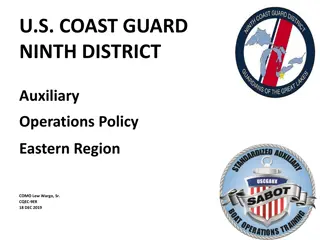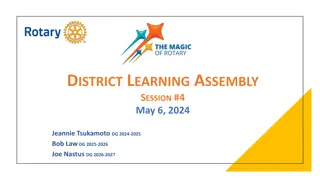District Assessment Coordinator Training Session
This document contains information about a training session for school assessment coordinators focusing on paper-pencil administration. It includes presentations, agenda details, acronyms, responsibilities, commonly used acronyms, and changes for the 2024-2025 academic year.
Download Presentation

Please find below an Image/Link to download the presentation.
The content on the website is provided AS IS for your information and personal use only. It may not be sold, licensed, or shared on other websites without obtaining consent from the author.If you encounter any issues during the download, it is possible that the publisher has removed the file from their server.
You are allowed to download the files provided on this website for personal or commercial use, subject to the condition that they are used lawfully. All files are the property of their respective owners.
The content on the website is provided AS IS for your information and personal use only. It may not be sold, licensed, or shared on other websites without obtaining consent from the author.
E N D
Presentation Transcript
2019 2019- -20 School Year 20 School Year Discipline Data Discipline Data December 4, 2020
Outline Discipline Data Overview Discipline Data Caveats Overall Findings School Year 2019-20 Incidents Resulting in Suspension/Expulsion, by Population Conclusions
Discipline Data Overview The Nevada Department of Education (NDE) collects various discipline data for the annual Nevada Report Card.1 One collection gathers information on the total number of incidents at school, district, and state levels resulting in suspension or expulsion.2 An additional discipline collection, new for school year (SY) 2019-20, gathers information on incidents resulting in suspension or expulsion, by population.3 These data are the focus of this presentation. 1The Nevada Report Card can be accessed at http://nevadareportcard.nv.gov/di/. 2Discipline data can be accessed via the Safety tab at the Nevada Report Card link provided in footnote #1. 3Discipline data by population can be accessed at http://nevadareportcard.nv.gov/DI/more?path=recents.
Discipline Data Caveats Discipline data may not be comparable district to district or school to school, as discipline definitions and practices are different across the state. Discipline data are complex. NDE collects by incident and population. Incidents do not necessarily correspond one-to-one with suspensions/expulsions. Example: If a student is suspended once for multiple incidents (say, violence to students, violence to staff, and possession of a weapon), they may be reported three times. In addition, if the suspended student is male, White, and FRL-eligible, they may be reported an additional three times under each incident category. Thus, this suspension could be reported a total of nine times. Therefore, it is difficult to compare and/or summarize discipline data.
Overall Findings The SPCSA has a lower rate of incidents resulting in suspensions than the state overall and for all populations. SPCSA 0.90 incidents per 100 students SPCSA versus State State 3.44 incidents per 100 students SPCSA students identifying as Black/African American or male along with those that have a disability are more likely to be involved in an incident resulting in a suspension than their peers, reflecting state1 and prior CRDC2 data. SPCSA 2.08 incidents per 100 Black/African American students 1.33 incidents per 100 male students 1.17 incidents per 100 students with disabilities 1Per the September 17, 2020 Nevada State Board of Education meeting, accessed via http://www.doe.nv.gov/State_Board_of_Education/. 2The federal Civil Rights Data Collection (CRDC), 2017 survey year for SPCSA, accessed at https://ocrdata.ed.gov/profile/9/district/54521/disciplinereport.
Incidents Resulting in Suspension/Expulsion, by Population Incident categories and populations collected by the NDE include: Incident categories resulting in suspension or expulsion: Populations Gender Violence to Students Race/Ethnicity Violence to School Staff Economically Disadvantaged (FRL) Possession of Weapons Students with Disabilities (IEP) Sale/Distribution of Controlled Substances English Learners (EL) Possession/Use of Controlled Substances Migrant Possession/Use of Alcohol Homeless Bullying Foster Cyberbullying Habitual Disciplinary Problems Military Incidents do not correspond one-to-one with suspensions/expulsions. One suspension may appear under multiple incident categories and populations; for example, an FRL-eligible male student suspended for violence to staff and possession of a weapon may be counted four times.
Incidents Resulting in Suspension/Expulsion, by Population Incidents Resulting in Suspension Rate Per 100 Students 2.08 1.33 1.17 1.02 0.94 0.90 0.81 0.73 0.68 0.47 0.38 n<10 n<10 n<10 n<10 n<10 n<10 Incidents Resulting in Expulsion Rate Per 100 Students n<10 n<10 n<10 n<10 n<10 0.02 n<10 n<10 n<10 n<10 n<10 n<10 n<10 n<10 n<10 n<10 n<10 October 1 2019 Enrollment Incidents Resulting in Suspension Incidents Resulting in Expulsion Population Black/African American Male Students with Disabilities (IEP) Economically Disadvantaged (FRL) Two or More Races SPCSA Hispanic/Latino Asian White Female English Learners (EL) American Indian/Alaskan Native Pacific Islander Foster Military Homeless Migrant 5752 24550 4666 17919 4346 49420 16446 3675 18183 24870 3397 222 796 69 2204 522 26 120 328 55 184 41 447 134 27 124 119 13 n<10 n<10 n<10 n<10 n<10 n<10 n<10 n<10 n<10 n<10 n<10 11 n<10 n<10 n<10 n<10 n<10 n<10 n<10 n<10 n<10 n<10 n<10 Rate = Total number SY 2019-20 incidents resulting in suspension or expulsion divided by the corresponding group s October 1 2019 enrollment count, multiplied by 100. The SPCSA rate was calculated via gender incident counts. To protect student privacy, n-counts less than 10 and their corresponding rates are displayed as n<10 . SPCSA data include former ASD schools. Incidents do not correspond one-to-one with suspensions/expulsions.
Incidents Resulting in Suspension per 100 Students, by Population Off chart at 36.99 SPCSA State 14 12 Incidents per 100 students 10 8 6 4 2 0 Am Econ Disadv (FRL) Stud w/Disab (IEP) Bl/Afr Amer Hispanic/ Latino Two or More Eng Lrnr (EL) Overall Female Male Asian White Ind/AK Native Pacf Isl Foster Military Hmls Migrant SPCSA 0.00 n<10 0.00 n<10 0.00 n<10 0.00 n<10 0.00 n<10 0.00 n<10 0.90 0.47 1.33 0.73 2.08 0.68 0.81 0.94 1.02 1.17 0.38 State 3.44 2.32 4.53 1.00 9.35 2.09 3.12 4.79 3.62 3.24 3.52 5.65 3.28 13.81 11.55 36.99 6.71 Rate = Total number SY 2019-20 incidents resulting in suspension divided by the corresponding group s October 1 2019 enrollment count, multiplied by 100. The SPCSA rate was calculated via gender incident counts. State data via the September 17, 2020 Nevada State Board of Education meeting. To protect student privacy, n-counts less than 10 and their corresponding rates are displayed as n<10 . SPCSA data include former ASD schools. Incidents do not correspond one-to-one with suspensions/expulsions.
Conclusions Compared to the state, the SPCSA has a lower rate of incidents resulting in suspensions overall and for all populations. However, SPCSA students identifying as Black/African American or male along with those that have a disability are more likely to be involved in an incident resulting in a suspension than their peers, reflecting state1 and prior CRDC2 data. These and other data (ex. state assessments, graduation rates) point to inequities in the educational experiences of students. Many educational institutions face this challenge. The SPCSA has initiated steps to confront these realities (ex. strategic initiatives, needs assessment). At each step in the charter authorizing life cycle (approval/denial, amendment, renewal), the SPCSA has an opportunity to influence and improve outcomes for all students. Many SPCSA schools are also striving to address issues around equity. 1Per the September 17, 2020 Nevada State Board of Education meeting, accessed via http://www.doe.nv.gov/State_Board_of_Education/. 2The federal Civil Rights Data Collection (CRDC), 2017 survey year for SPCSA, accessed at https://ocrdata.ed.gov/profile/9/district/54521/disciplinereport.


